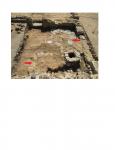Summary (English)
The 2017 campaign aimed to recover and check the data that emerged in recent years, with a view to reconstructing the chronological seriation of the quarter’s life.
For this reason, the investigation continued in room D10 (2016), enlarging the area in order to understand the relationship between the so-called macellum and the Small Baths, and therefore reconstruct the area’s urban fabric prior to the intervention on the baths complex in the Severan period. A craft working space was identified, perhaps a pistrinum? with a carriage gateway facing onto the portico of the port road and a lateral pedestrian entrance. Unfortunately, the weather conditions prevented further excavation to confirm the structure’s function, suggested by the presence of two stone circles that could have been rests for millstones.
The investigation of the area behind the bath building also continued, where in 2014 a specific intervention took place in order to permit the construction of a covering for the apodyterium mosaic. In 2011, three sides of a room were identified here, one formed by a mud-brick partition wall, plastered in white with a red and blue band. This year, the fourth side of the room was identified. The room was used to dump building materials from the adjacent bath building when no longer in use (5th century A.D.?). After a period of abandonment a wall was built, more or less without foundations (directly on the earth), which, together with the other elements associated with it, represents the quarter’s latest occupation period.
In order to understand the quarter’s later phases, the visible remains were surveyed using a total station and a new excavation area was chosen (C2) in a space which should not have been touched by previous research. The area was surrounded by walls inside which several layers containing abundant building material were identified, relating to a gradual collapse, continued dumping and the partial robbing of the remains.
This season’s excavations represent only a part of a much wider research programme; the results must be read in relationship both to the stratigraphy and to the information provided by the finds study.
- Bianca Maria Giannattasio - Università degli Studi di Genova
Director
- Arch. Fausto Martino- Soprintendenza per i Beni Archeologici per le province di Cagliari e Oristano
- Bianca Maria Giannattasio - Università degli Studi di Genova
- Gianfranca Salis - Soprintendenza dei beni archeologici per le province di Cagliari e Oristano
Team
- Bianca Maria Giannattasio - Università degli Studi di Genova
- Silvia Pallecchi - Università degli Studi di Genova
- Anna Parodi - Università degli Studi di Genova
- Elena Santoro- Università degli Studi di Genova
- Irene Cimoli- Università degli Studi di Genova
- Michele Grippo- Università degli Studi di Genova
Research Body
- Research Body: Università degli Studi di Genova, Dipartimento Antichità, Filosofia, Storia (D.A.FI.ST.)
Funding Body
- Università degli Studi di Genova






![Download [PDF]](/excavation/skins/fasti/images/results/download_sml.png)